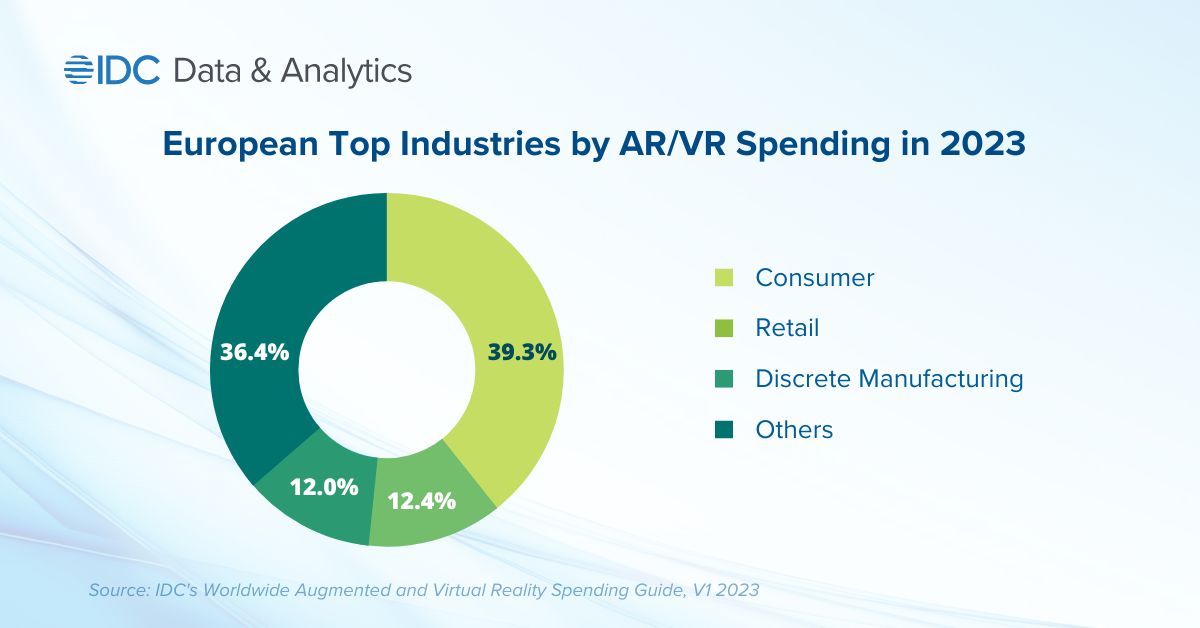According to International Data Corporation’s (IDC) Worldwide Augmented and Virtual Reality Spending Guide, European augmented reality and virtual reality (AR/VR) spending will reach $1.1 billion and $3.4 billion, respectively, in 2023. By 2027, AR/VR spending will reach $10.5 billion, growing at a 24.9% CAGR for 2022–2027. Though AR/VR spending has been revised down since the previous forecast due to high inflation and other macroeconomic conditions, spending will grow 32.0% this year. This shows how AR and VR are strategic technologies to support organizations’ business goals.
“As a response to the challenging macroeconomic conditions, many European companies are adopting a more cautious approach to IT investments, pushing back some large AR/VR deployments,” said Lubomir Dimitrov, research manager, IDC Data and Analytics, Europe. “However, the change in priorities, emphasizing optimization of ROI and productivity and efficiency gains, will continue to intensify interest in AR and VR, propelled by the digital trend of ‘remote everything’ and keeping a strong focus on employee safety.”
Consumer, retail, and discrete manufacturing will be the top spending industries in 2023, accounting for 63.7% of total spending. In the B2B space, resource industries will experience the fastest long-term growth, with double-digit growth throughout the forecast period. AR/VR help businesses improve efficiencies by enabling quick remote support and problem resolution in the event of asset failure, increase productivity by augmenting human capabilities, and enhance safety by substituting often risky onsite training with safe virtual instructions. In the resource industry, safety is crucial, and AR enables experts to virtually inspect both machinery and the surrounding environment, enabling detailed and accurate inspection of dangerous areas without endangering site operators.
 Training, online retail showcasing, and industrial maintenance will take the biggest share of B2B use case investments in 2023. Virtual training has become more popular as it helps employees acquire skills quickly and in an interactive way, providing hands-on, engaging, virtual learning experiences in a safe environment. Virtual training is also a more cost-effective alternative to traditional training in industries such as manufacturing and transportation. Collaboration will be the fastest growing use case by 2027, growing at an 89.2% five-year CAGR. As remote and hybrid working has become the new normal, AR/VR plays a crucial role in addressing remote collaboration needs. They enable companies to go beyond traditional video- and audioconferencing tools, providing employees with more immersive and engaging experiences and guaranteeing continuity of critical team activities.
Training, online retail showcasing, and industrial maintenance will take the biggest share of B2B use case investments in 2023. Virtual training has become more popular as it helps employees acquire skills quickly and in an interactive way, providing hands-on, engaging, virtual learning experiences in a safe environment. Virtual training is also a more cost-effective alternative to traditional training in industries such as manufacturing and transportation. Collaboration will be the fastest growing use case by 2027, growing at an 89.2% five-year CAGR. As remote and hybrid working has become the new normal, AR/VR plays a crucial role in addressing remote collaboration needs. They enable companies to go beyond traditional video- and audioconferencing tools, providing employees with more immersive and engaging experiences and guaranteeing continuity of critical team activities.






























